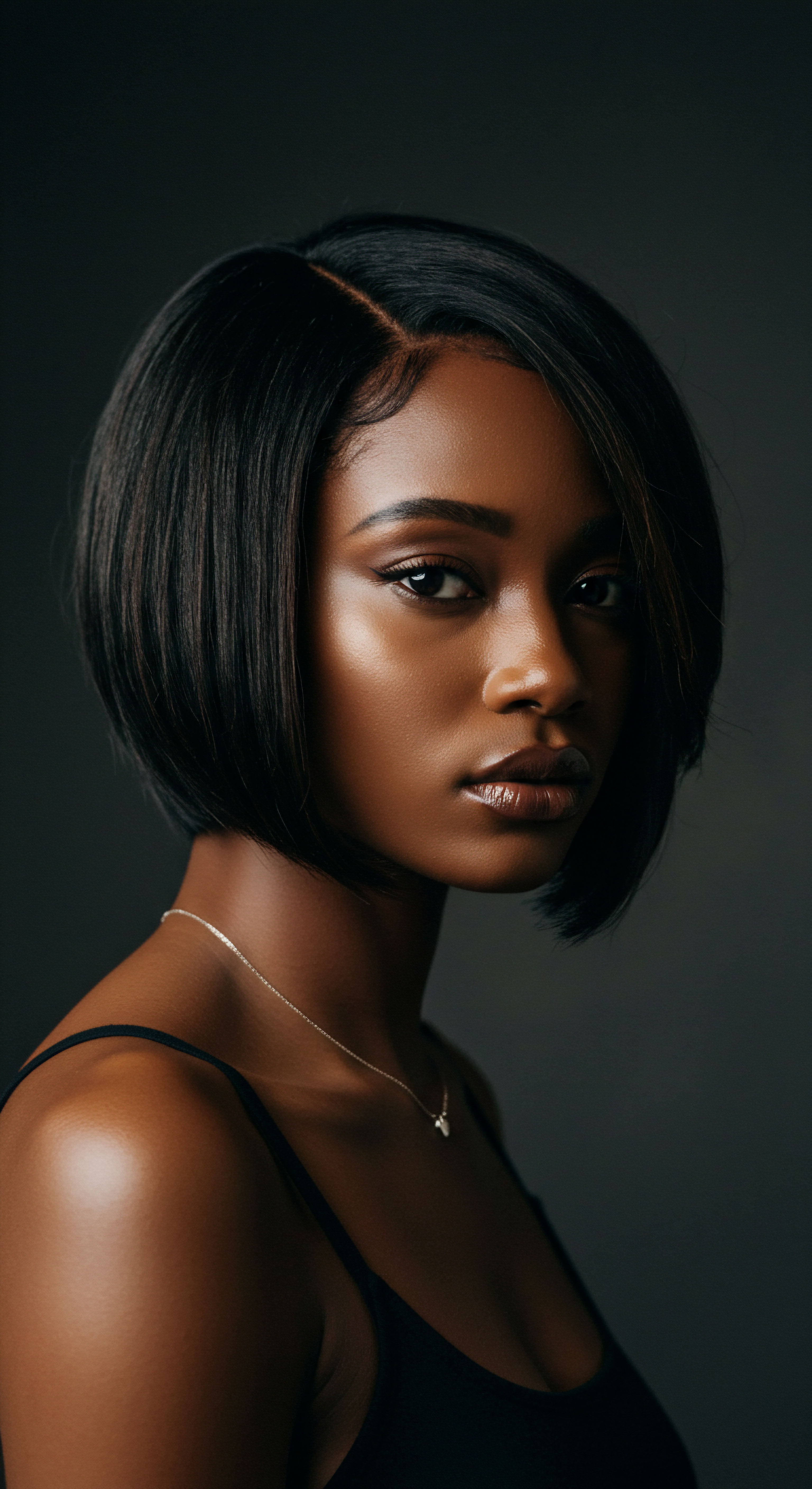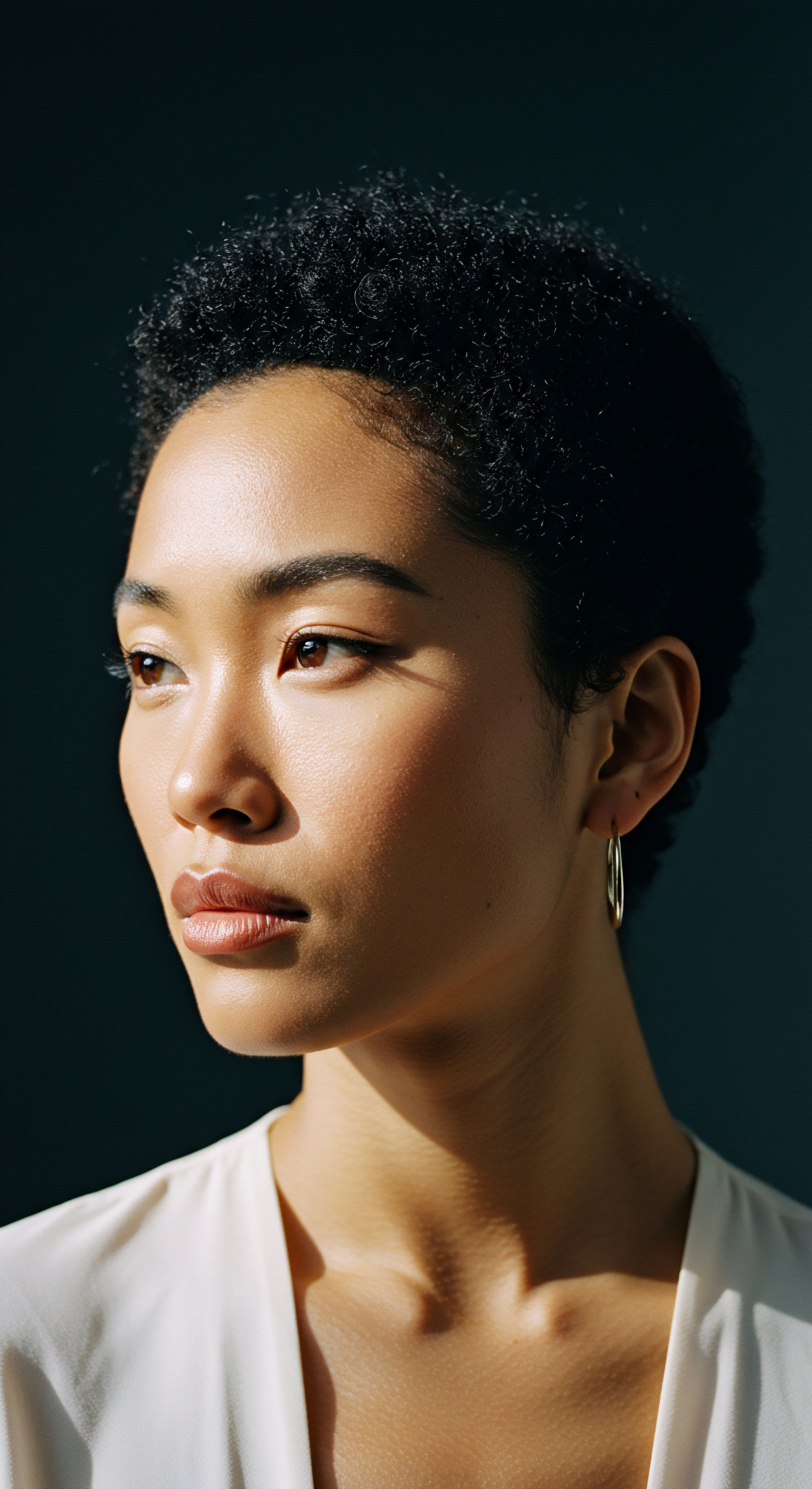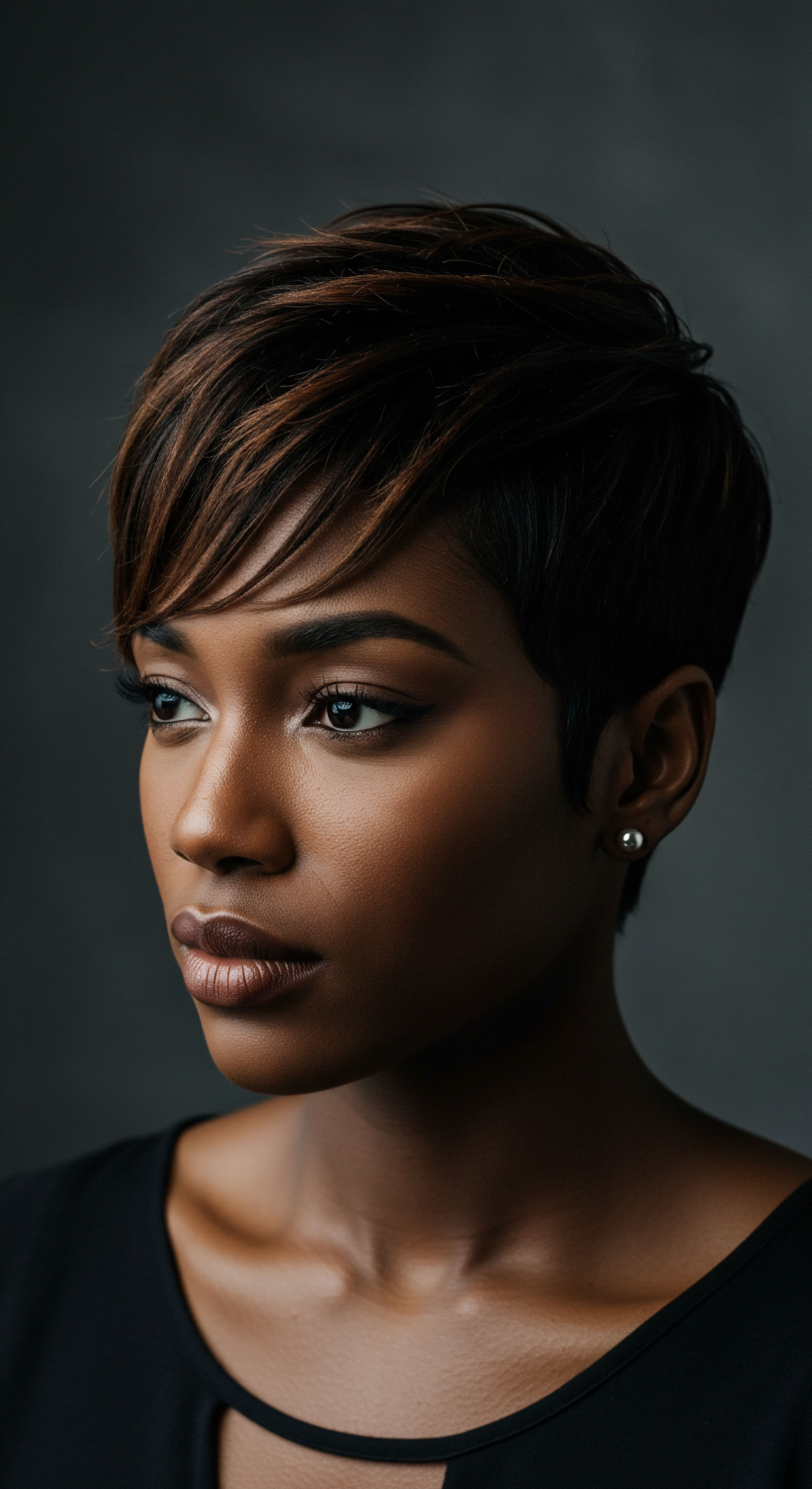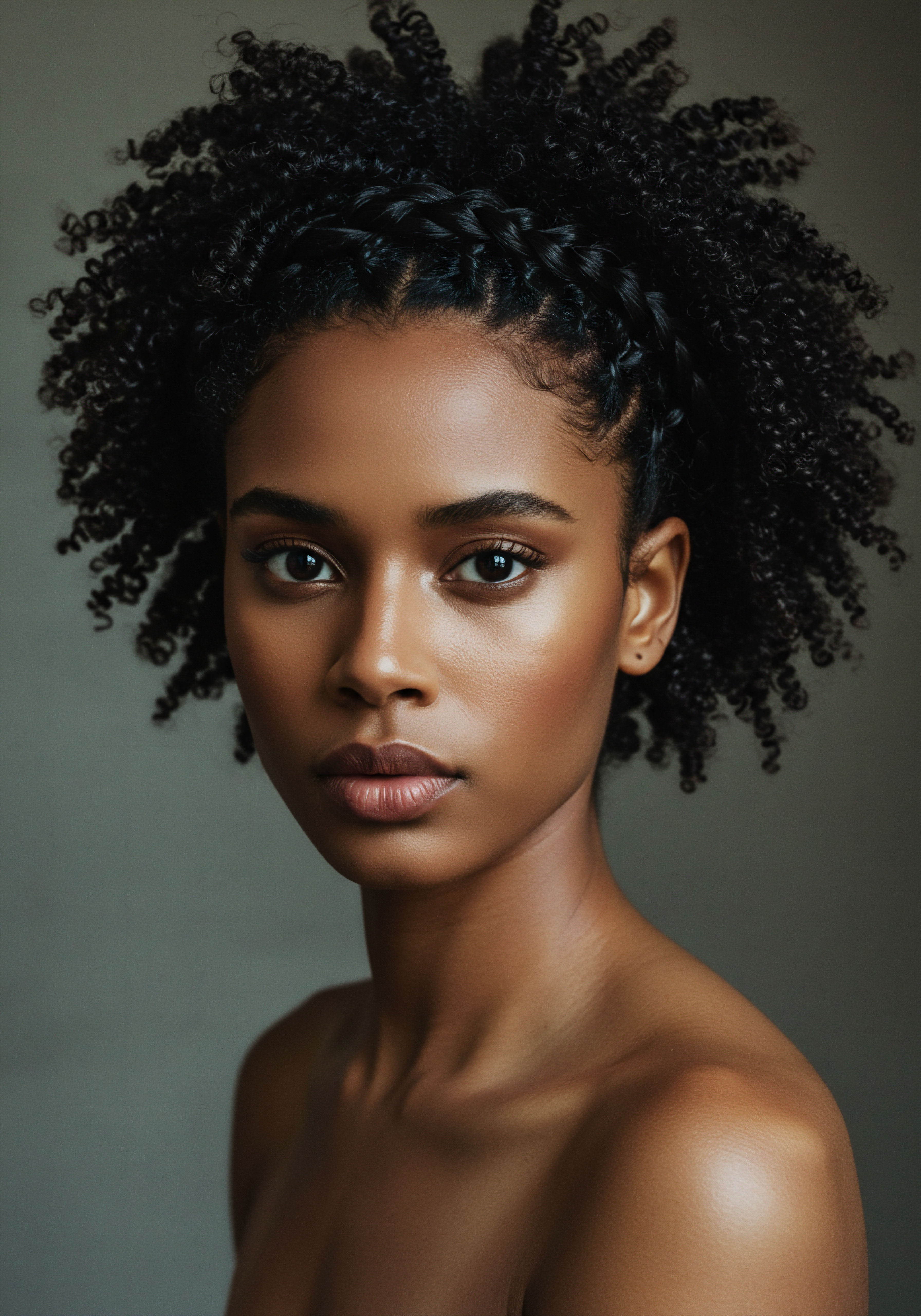
Roots
The whisper of silk against a tender scalp, the gentle embrace of a bonnet as twilight descends – these are not merely acts of adornment or habit, but profound moments in the quiet, intricate dance between ourselves and our inner landscape. Beneath the surface of our skin, a world of microscopic life thrives, an ecosystem of bacteria and fungi collectively known as the scalp microbiome. This unseen realm, as vital as the soil nurturing a mighty tree, profoundly influences the vitality and strength of our hair. To truly understand the role bonnets play in our nightly rituals, we must first descend into the foundational understanding of this living canopy, recognizing its delicate equilibrium and the myriad factors that shape its health.

What is the Scalp Microbiome?
The scalp, a unique expanse of skin, serves as a rich habitat for a diverse array of microorganisms. Unlike other body regions, it boasts a higher density of hair follicles and sebaceous glands, creating a distinct microenvironment. This environment, characterized by its moisture, acidity, and lipid content, provides a welcoming home for specific microbial communities.
Among its primary residents are bacteria like Cutibacterium Acnes and Staphylococcus Epidermidis, alongside the fungus Malassezia. These microorganisms, far from being mere passengers, participate in a symbiotic relationship with our scalp, contributing to its protective barrier, modulating inflammatory responses, and even aiding in the breakdown of sebum, the natural oil our scalp produces.
The scalp microbiome, a complex ecosystem of bacteria and fungi, is fundamental to the health and vitality of our hair.
A healthy scalp microbiome operates in a state of balanced diversity. It is a harmonious community where beneficial microbes compete with potential pathogens, limiting their unchecked proliferation and reducing the risk of infections. When this delicate balance is disrupted, a condition known as dysbiosis can arise, leading to various scalp concerns.

Key Components of Scalp Microbiome Balance
- Sebum Production ❉ The scalp’s sebaceous glands secrete sebum, a natural oil composed of lipids, triglycerides, and waxes. Sebum provides essential nutrients to hair follicles and acts as a protective barrier against external aggressors. The microbiome plays a significant part in regulating this production; too much can lead to greasiness, while too little results in dryness.
- PH Balance ❉ The scalp’s pH level, ideally between 4.5 and 5.5, influences the overall health of the scalp and the hair’s condition. A balanced pH supports the growth of beneficial microorganisms and discourages the overgrowth of harmful ones. Disruptions can lead to dryness, dandruff, and damage.
- Moisture Levels ❉ The scalp’s hydration is closely tied to its barrier function. Proper moisture levels are crucial for healthy skin cells and the overall integrity of the scalp’s protective shield. An occluded environment can influence water diffusion and hydration values, potentially impacting the skin’s permeability.
Understanding these foundational elements allows us to appreciate how external practices, such as wearing bonnets, can subtly influence this internal ecosystem. The choices we make for our hair at night extend beyond mere aesthetic considerations, reaching into the microscopic world that governs scalp wellness.

Ritual
The nightly ritual of covering our hair, particularly for those with textured strands, is a practice steeped in practical wisdom and a desire for protection. It is a moment of intentional care, a gesture that shields delicate curls and coils from the rigors of sleep. Yet, as we draw our bonnets over our heads, we step into a conversation with our scalp’s unseen inhabitants, influencing the microclimate that shapes their lives. This section considers the direct ways in which bonnets, as part of our care regimen, interact with the scalp’s microbial balance, moving beyond simple protection to a deeper understanding of their influence.

How Do Bonnets Alter the Scalp Environment?
Bonnets, typically crafted from smooth materials like silk or satin, are celebrated for their ability to reduce friction, retain moisture, and prevent tangles and breakage during sleep. While these benefits for the hair strand are widely recognized, their impact on the scalp itself, and by extension its microbial community, is a more nuanced consideration. The very act of covering the scalp creates a localized microclimate, one that can differ significantly from an exposed scalp.
One of the primary alterations is the modification of Humidity and Temperature. A bonnet can trap warmth and moisture close to the scalp, leading to an increase in localized humidity. For certain microorganisms, particularly some fungi like Malassezia, high humidity provides a favorable environment for growth. While Malassezia is a normal resident of the scalp, its overgrowth is frequently associated with conditions such as dandruff and seborrheic dermatitis.
Another consideration is the potential for altered Sebum Distribution and Accumulation. Textured hair, with its unique curl pattern, often experiences challenges with sebum traveling down the hair shaft, leading to more oiliness at the scalp and dryness at the ends. Bonnets, by reducing friction and preventing hair from rubbing against pillowcases, might contribute to a greater concentration of sebum at the scalp surface. While sebum is vital, excessive buildup can create a barrier that impedes the healthy activity of beneficial microorganisms and contributes to scalp issues.
Bonnets create a localized microclimate around the scalp, influencing humidity, temperature, and sebum distribution.

Choosing the Right Bonnet Material and Fit
The material of a bonnet plays a significant role in its impact on the scalp. Silk and Satin are preferred due to their smooth surfaces, which minimize friction and do not absorb moisture from the hair as readily as cotton. Cotton, for instance, can absorb up to 25% of its weight in moisture, potentially drawing hydration away from the hair and scalp.
Silk, by contrast, absorbs only around 11%, helping to maintain the hair’s natural moisture balance. This moisture retention can be beneficial for hair health, yet it simultaneously contributes to the occlusive environment around the scalp.
The fit of a bonnet is also a critical factor. An overly tight bonnet can exert pressure on the scalp, potentially leading to irritation or even contributing to Traction Alopecia over time. Such pressure can compromise blood circulation to the hair follicles and disrupt the delicate skin barrier, making the scalp more susceptible to imbalances. A bonnet that is too loose, however, may not stay in place, diminishing its protective benefits for the hair.
A thoughtful approach to bonnet use involves selecting breathable materials and ensuring a comfortable, secure fit that avoids unnecessary tension. This mindful practice allows us to harness the benefits of protective headwear for our hair while remaining attuned to the subtle shifts occurring within our scalp’s living surface.

Relay
Stepping beyond the immediate observations of bonnet use, we enter a realm where science, cultural practice, and environmental factors converge to shape the scalp’s microbial narrative. How do the nuanced interactions within this occluded microenvironment truly alter the microbial balance, and what implications does this hold for long-term scalp wellness, particularly within communities where head coverings are a regular practice? This deeper inquiry calls upon a more academic lens, examining the intricate interplay of biological mechanisms and lived experiences.

Do Head Coverings Change Scalp Microbial Populations?
The question of how continuous head covering influences the scalp microbiome has gained scholarly attention, particularly in contexts where such practices are common. Research indicates that prolonged occlusion, whether from bonnets, scarves, or other headwear, can indeed lead to measurable changes in the scalp’s microenvironment. This altered environment can favor the proliferation of certain microbial species over others, potentially tipping the balance towards dysbiosis.
A notable cross-sectional study conducted from August 2019 to April 2021 compared the scalp microbiome of healthy women wearing hijabs daily (for a minimum of 8 hours a day for at least 5 years) to those not wearing hijabs. The findings revealed significant differences in microbial dominance between the two groups. Specifically, the study observed that Staphylococcus Capitis was more prominent in the hijab-wearing group, while Staphylococcus Cohnii was more prominent in the non-hijab group. More significantly, Malassezia Restricta, a fungus frequently associated with dandruff and seborrheic dermatitis, was more common in the hijab-wearing group, whereas Malassezia Globosa was more common in the non-hijab group.
This suggests that the prolonged occlusive environment created by head coverings, including bonnets, can alter the fungal and bacterial populations on the scalp, potentially increasing susceptibility to conditions like seborrheic dermatitis. Indeed, the study indicated that women wearing hijabs were more prone to seborrheic dermatitis, with 59.3% of 509 hijab-observing women reporting subjective deterioration of scalp health. This is a compelling piece of evidence suggesting that while bonnets offer protective benefits for hair strands, their continuous use without appropriate scalp care can contribute to an altered microbial landscape.
The occlusive effect of head coverings can inhibit water diffusion from the scalp, leading to increased skin hydration values by up to 50%. This heightened moisture can swell corneocytes and promote water uptake into intercellular lipid domains, increasing the stratum corneum’s permeability and elevating the skin’s pH. An elevated pH, moving away from the scalp’s naturally acidic state (around 4.5-5.5), can disrupt the optimal environment for beneficial microbes and create conditions conducive to the overgrowth of opportunistic pathogens.
Prolonged head covering can shift scalp microbial populations, potentially increasing the presence of certain fungi and bacteria associated with scalp concerns.

Managing the Microclimate Under a Bonnet
Given these insights, the approach to bonnet use extends beyond simple application to a thoughtful regimen of care. Maintaining a healthy scalp microbiome under any occlusive headwear necessitates conscious practices that mitigate the potential for imbalance.
- Consistent Cleansing Practices ❉ Regular, gentle cleansing is paramount to remove excess sebum, sweat, and dead skin cells that can accumulate under a bonnet. For those with textured hair, who may not wash their hair as frequently as others, incorporating scalp-specific cleansing methods, such as diluted shampoos or scalp rinses, can be beneficial even while in protective styles. The goal is to cleanse without stripping the scalp’s natural oils, preserving its delicate barrier.
- Ensuring Adequate Air Circulation ❉ While bonnets offer protection, periods of scalp exposure to air can help regulate temperature and humidity. Allowing the scalp to breathe, perhaps during waking hours or on days when hair is not covered, can assist in preventing the prolonged warm, moist environment that certain microbes prefer.
- PH-Balanced Products ❉ Selecting hair care products that respect the scalp’s natural pH (between 4.5 and 5.5) helps to maintain an optimal environment for the microbiome. Harsh chemicals or overly alkaline products can disrupt this balance, making the scalp more vulnerable to dysbiosis.
- Mindful Moisture Management ❉ While bonnets help retain moisture in the hair, it is crucial to ensure that the scalp itself is not excessively damp before covering. Sleeping with wet hair, especially under an occlusive covering, creates an ideal breeding ground for fungi and bacteria. Ensuring hair and scalp are thoroughly dry before bonnet application is a simple yet impactful step.
These practices, when integrated into a hair care routine, help to harmonize the protective benefits of bonnets for hair strands with the foundational need for a balanced scalp microbiome. It becomes a conscious decision to foster a thriving environment, acknowledging the unseen life that supports our hair’s health.
| Factor Humidity |
| Impact on Scalp Microenvironment Increased moisture retention and warmth |
| Potential Microbiome Shift Increased Malassezia species, potential for fungal overgrowth |
| Factor Sebum Accumulation |
| Impact on Scalp Microenvironment Reduced friction allows sebum to stay localized |
| Potential Microbiome Shift Alteration in Cutibacterium acnes and Staphylococcus epidermidis balance |
| Factor pH Elevation |
| Impact on Scalp Microenvironment Occlusion can increase skin pH due to hydration |
| Potential Microbiome Shift Shift favoring opportunistic pathogens, less optimal for beneficial microbes |
| Factor Reduced Airflow |
| Impact on Scalp Microenvironment Less ventilation, potential for anaerobic conditions |
| Potential Microbiome Shift Favors certain bacterial species that thrive in low oxygen environments |
| Factor Understanding these dynamics allows for targeted care strategies to support scalp health while using bonnets. |

Reflection
Our exploration into the world beneath the bonnet reveals a landscape far richer and more responsive than one might initially perceive. The seemingly simple act of covering hair at night resonates with the complex biological symphony of the scalp microbiome, inviting us to a deeper relationship with our hair’s true foundation. We learn that true hair wellness extends beyond visible strands, delving into the unseen life that governs their vitality. It is a continuous dialogue, a dance between protection and breath, tradition and science, all guided by the gentle wisdom of understanding.

References
- 1. Penny James Trichology. A Guide to Scalp Microbiome. 2023.
- 2. BiomeCentric. The scalp microbiome ❉ The key to next-gen hair care. 2024.
- 3. UZIMA. Three Truths About Scalp Care for Textured Hair. 2023.
- 4. Oceane Avakian. The Importance of Sebum for Your Scalp.
- 5. An’du. 10 Reasons Why You Want a Healthy Scalp Microbiome. 2025.
- 6. Beautycon.com. How to Care for Your Scalp While Wearing Braids & Twists. 2023.
- 7. Rene Furterer. Scalp microbiome ❉ its definition and role.
- 8. Hair.com By L’Oréal. Scalp Care & Protective Styles ❉ What You Need To Know To Maintain Healthy Hair. 2022.
- 9. Refinery29. How To Look After Your Scalp In A Protective Style. 2022.
- 10. LANI SILK. How Silk Bonnets Transform Hair Health ❉ Expert Insights and Evidence. 2025.
- 11. The Benefits of a 100% Silk Hair Bonnet for Healthy Hair. 2024.
- 12. Fro Plus Fashion. 3 Easy Ways to Refresh Your Scalp In Protective Styles. 2018.
- 13. How Bonnets for Hair Help Preserve Your Perfect Style? 2025.
- 14. Clinikally. Scalp Biomes ❉ Personalized Haircare for Your Unique Flora. 2024.
- 15. Hair.com By L’Oréal. Protective Hairstyles ❉ The Ultimate Guide To Styling And Care.
- 16. Scalp Microbiome Explained ❉ What’s Living on Your Scalp and Why It Matters. 2025.
- 17. N. S. Nurazizah et al. Scalp microbiome of healthy women wearing hijab compared to those not wearing hijab ❉ A cross-sectional study. ResearchGate, 2023.
- 18. The Steam Bar. Embracing humidity for your hair.
- 19. R. Singh, R. S. K. Gupta. Occlusion Effect on in vivo Percutaneous Penetration of Chemicals in Man and Monkey ❉ Partition Coefficient Effects. ResearchGate.
- 20. Afro-Ethnic Hairstyling Trends, Risks, and Recommendations. MDPI, 2022.
- 21. Bacteria Display Differential Growth and Adhesion Characteristics on Human Hair Shafts. mSystems – ASM Journals, 2018.
- 22. Does Wearing a Bonnet Cause Hair Loss? Protective Styling and Hair Health. 2025.
- 23. Harper’s Bazaar India. Are we focusing on scalp skin barrier enough? 2025.
- 24. Fulham Scalp and Hair Clinic. How Do You Fix A Scalp Microbiome? Understanding The Gut-Skin Axis. 2023.
- 25. Comparison of fungal species on scalp microbiome of healthy woman. – ResearchGate.
- 26. Is high microbial diversity a guarantee for good skin and scalp health? 2023.
- 27. Humidity’s Impact on Hair & Scalp. NAJEAU.
- 28. Behind the Scenes ❉ The Science of Satin – How Sleeping With Our Hair Bonnets Promote Healthier Dreadlocks AKA Locs. 2024.
- 29. Clinical Translation of Microbiome Research in Alopecia Areata ❉ A New Perspective? MDPI.
- 30. Hair Microbiome Diversity within and across Primate Species. mSystems – ASM Journals, 2022.
- 31. Hairborist. Focus on the scalp microbiome ❉ what is its role and importance?
- 32. Techniques Used for Hair Style Maintenance while Sleeping May Be a Risk Factor for Traction Alopecia. PMC, 2021.
- 33. Nutrafol. What Is Your Scalp Microbiome and Why It’s Key to Healthy Hair. 2024.
- 34. Relationship between the bacterial community structures on human hair and scalp. Taylor & Francis Online.
- 35. N. S. Nurazizah et al. Evaluation of Scalp Hydration and pH Values in Hijab-Wearing and Non-Hijab-Wearing Women. PMC, 2023.
- 36. A Study on Scalp Hair Health and Hair Care Practices among Malaysian Medical Students. ResearchGate.
- 37. Scalp Microbiome and Dandruff—Exploring Novel Biobased Esters. MDPI.
- 38. A Community-Based Study of Hair Care Practices, Scalp Disorders and Psychological Effects on Women in a Suburban Town in Southwest Nigeria. ResearchGate.
- 39. A Study on Scalp Hair Health and Hair Care Practices among Malaysian Medical Students. 2017.
- 40. New Topicals to Support a Healthy Scalp While Preserving the Microbiome ❉ A Report of Clinical and in Vitro Studies. 2023.
- 41. The Genomic Variation in Textured Hair ❉ Implications in Developing a Holistic Hair Care Routine. MDPI.
- 42. Seborrheic Dermatitis and the Link to Hair Loss. UCF Health.